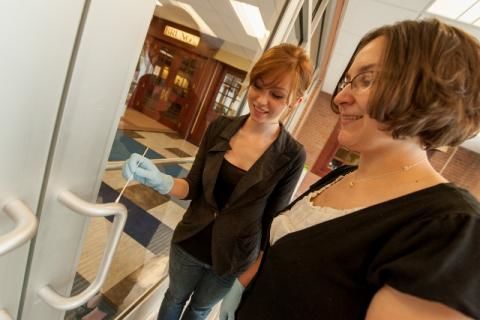Can a door handle keep you healthy?
That depends on what’s on it. Most are teeming with bacteria: staph, E. coli, Enterococcus and sometimes even Salmonella. That stuff can make you sick.
Doors in the Reed, Prischak, Burke and Junker buildings on campus are now coated with something different: Agion silver, an antimicrobial compound that doctors put on catheters and heart valves. Moisture – in this case, the sweat and oils on a person’s hand – activates the silver ions, which bind to the bacteria’s cell walls. The cells die, and the surface is cleaner.
“It does seem to be effective,” said Dr. Beth Potter, assistant professor of microbiology. Her students have swab-tested fifty door handles on campus, measuring bacterial differences on surfaces with and without the silver powder. The treated handles are consistently cleaner.
Manufacturers are applying the silver film to all kinds of products: cell phones, computer keyboards, staplers, electric razors. Office Depot puts it on pens. Adidas uses it to stop shoes from smelling bad.
Greg Yahn, president of Advanced Finishing USA, sprays the Agion film onto hospital doors. After a meeting with Dr. Diane Parente, professor of management and director of the Interdisciplinary Business with Engineering Studies program, he had ideas for even more uses. Students suggested adding the film to water bottles, bus-strap handles, gas pumps and emergency-exit panels.
“They really took it to the next level,” Yahn said. “They did the research, saw what was possible and turned a ‘what if’ discussion into something tangible.”
Parente then brought in Dr. Mary Beth Pinto, professor of marketing. Pinto’s students thought through the one problem Yahn had not been able to solve: How do you market an invisible product?
For an early test project – a stairwell railing in the Burke Center – Yahn had given the Agion film a bright white glossy finish. People were reluctant to touch it, thinking it was wet paint.
Yahn switched to a clear coating, which he applied to the door handles at two local Country Fair convenience stores. That look posed a different problem.
“If you walk up and grab the handle, you have no clue that it’s benefiting you,” Yahn said. “There’s nothing to give it away.”
Pinto’s students developed signs and logos that explained the value of Agion products. They surveyed shoppers, asking if they worried about germs. (Some didn’t. Others opened their purses, showing vials of hand sanitizer.) They filmed commercials, touting the benefits of antimicrobial products.
The next step, the students said, is to develop a small, industry-accepted logo – a mark similar to the Underwriters Laboratories stamp, or the recycling triangle – that consumers can use to identify Agion-coated surfaces.
“Ideally, we’ll get to some kind of identifiable symbol,” Yahn said. “Something like the Nike swoosh, where you know, from 10 feet away, ‘That’s antimicrobial. It’s OK to touch it.’”
